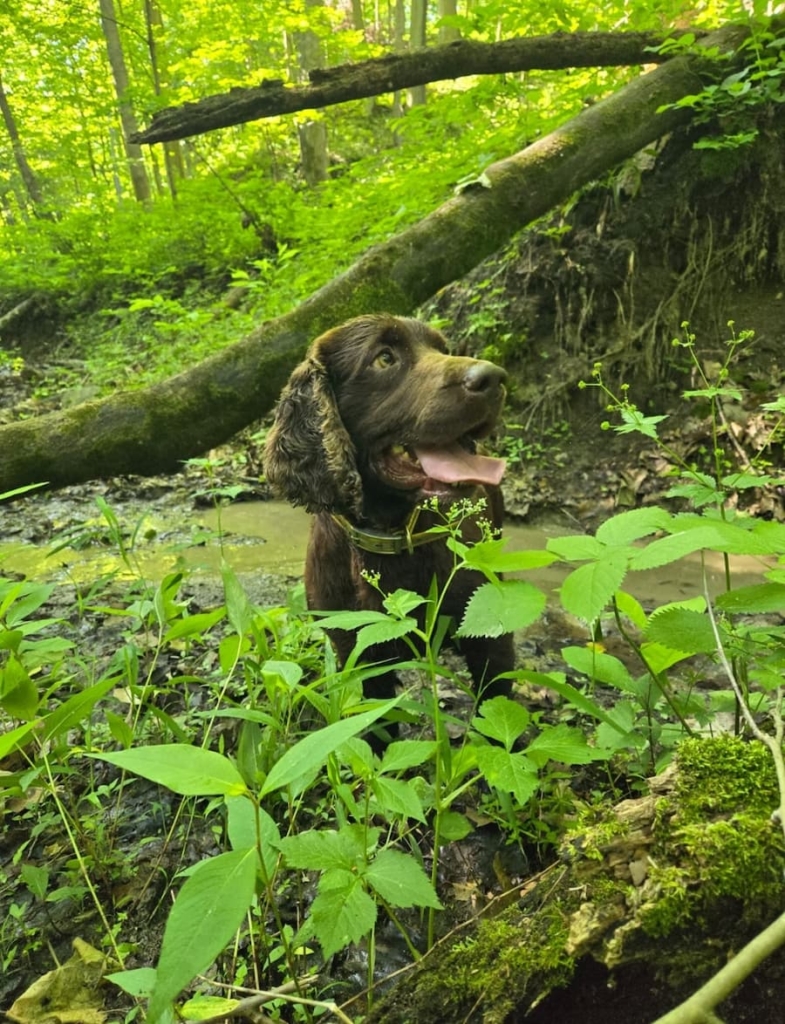Our first week of Turtle Team was a success! We found and worked up a total of 58 Eastern box turtles! This would not have been possible without the coordination and teamwork of all our participants. Each participant plays a valuable role in our greater effort of “Saving the world, one box turtle at a time.”
-
John Rucker and the dogs
John Rucker is the owner and trainer of six Boykin Spaniels who are the “turtle dogs.” This season, we are mainly working with the energetic trio of Yogi, Skeeter, and Ruger who are littermates. We have also seen appearances by their aunt Scamp, and Penny, a young turtle dog in training. These dogs have the unique skill of sniffing out turtles in dense forests and tall grasses that otherwise would be difficult to find with just the human naked eye. The magnitude of our research would not be possible without John and the dogs.
During our hikes, John and the dogs lead the way with everyone else trailing behind. Doing so allows the dogs the best opportunity to smell the turtles without contaminating the unsearched areas with human scents. When the dogs find a turtle, they pick it up with their soft mouths (a characteristic of their breed) and bring the turtle to a human.
-
Dr. Allender and Dr. Laura
Dr. Allender has been doing this research for many years, so he knows all the ins and outs of the field sites. Therefore, he serves as the primary navigator. Additionally, he keeps a close eye on the dogs to ensure that they appear well-hydrated and healthy throughout the hikes since they are a huge asset to our research. After the initial hike, Dr. Allender takes measurements of the turtles’ shells and identifies approximate age, sex, and whether it is a turtle we have worked with previously. Once we are done working up the turtles, Dr. Allender returns each one to the exact site where we found them.
Dr. Laura is in charge of collecting important data. For example, she collects information about the type of environment the turtle was found in, where the turtle was found, and which dog found the turtle. After the hike, Dr. Laura conducts physical exams of all the turtles found. This is extremely important to our interpretation of which turtles are healthy and which are not. She also obtains choanal, cloacal, and shell swabs for further disease testing.
-
Field team
This week, 21 students participated in our efforts in addition to some Wildlife Epidemiology Laboratory alumni. When we go in the field, we split the students into two groups: the odd team and the even team. Within each group, each student has a different job. Student jobs include labelling the turtles, GPS tracking, and monitoring the dogs. While the odd team is working on their turtle, the even team hikes ahead, and when the even team is working on their turtle, the odd team hikes ahead. It is like a game of leapfrog, which allows for efficiency of the group as a whole and the maximal collection of turtles.
When we return to base camp, students work on various steps to help work up the turtles. For example, students draw blood, take heart rates, and assist with physical exams and the collection of demographic information. Some students also assist Dr. Allender in returning the turtles at the end.
-
Lab team
The lab team helps us process the samples after we have returned from a day in the field. Students measure the packed cell volume and total solids in the blood, count heterophils and eosinophils in the blood via hemocytometers, measure erythrocyte sedimentation rates, and prepare plasma samples for further testing.
As you can see, Turtle Team requires an enthusiastic team of people to achieve our research goals. Keep up with us throughout the summer for more Turtle Team content!

